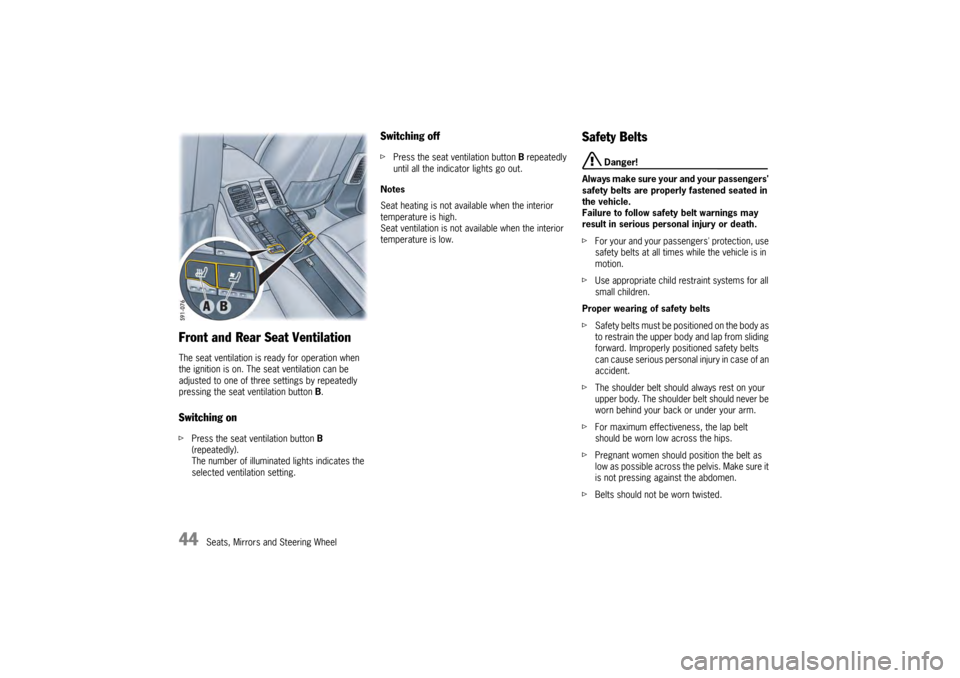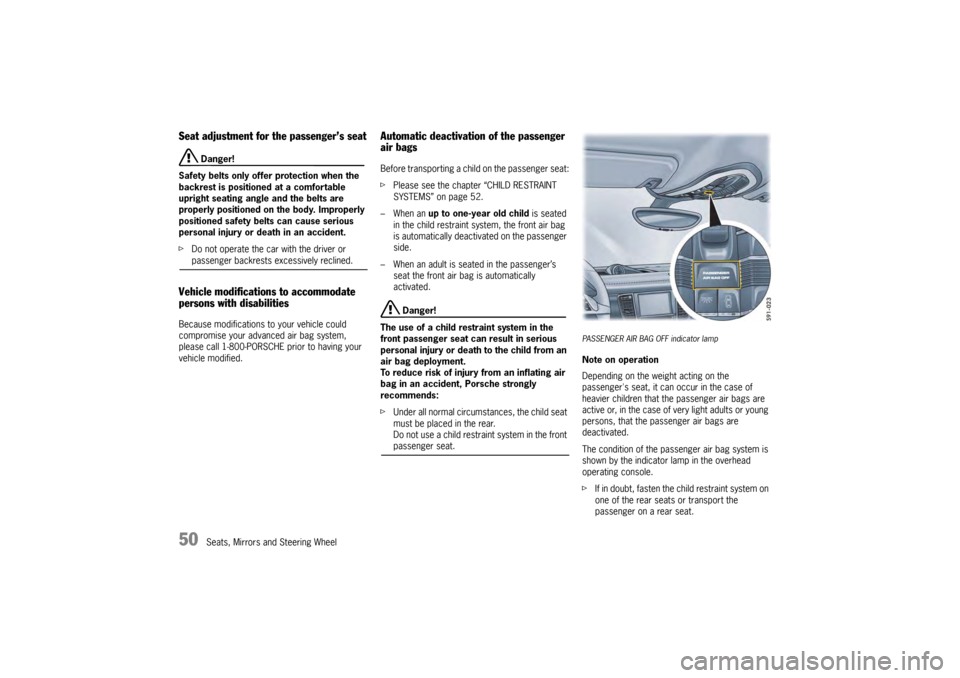2009 PORSCHE PANAMERA light
[x] Cancel search: lightPage 40 of 343

38
Seats, Mirrors and Steering Wheel
Seat Adjustment and Head
Restraints
Danger!
The seat may move unexpectedly if you
attempt to adjust while driving. This could
cause sudden loss of control, resulting in
serious personal injury or death.
f Do not adjust seats while the vehicle is in mo-
tion.The backrest locks must be engaged at all
times while the vehicle is in motion.
Safety belts only offer protection when the
backrest is upright and the belts are properly
positioned on the body.
Improperly positioned sa fety belts or safety
belts worn by passengers in an excessively
reclined position can cause serious personal
injury or death in an accident.
f Do not operate the car with the driver or
passenger backrests excessively reclined.
f Please see the chapter “SEAT POSITION” on
page 38.
Danger of injury if pe rsons or animals are in
the movement range of the seat during seat
adjustment.
f Adjust the seat so that no-one is put at risk.
f Do not activate the comf ort memory button if
there is any risk of the seat crushing the
occupant. f
Cancel automatic adjustment by pressing any
of the seat adjustment buttons.
f Do not leave children in the vehicle unattended,
since they may depress the comfort setting
button and crush themselves or another
occupant. Caution!
Risk of damage to wi ndshield, sun visor,
windstop, etc. when the seat is adjusted or
folded back or forward.
f Adjust the seat so that the s e a t b a c k re s t i s n o t in contact with any other object.
The driver, front, and back passenger seats
provide integrated head restraints in the
backrests. The head restraints are not adjustable. Warning!
All occupants, including the driver, should not
operate a vehicle or sit in a vehicle’s seat until the
head restraints and backrests, respectively, are
placed in their proper posi tions so that the risk of
neck injuries is minimize d in the event of a crash.
For a proper positioning of the head restraint, the
seatback’s inclination should be adjusted such
that the head restraint is in an upright position.
Driver and passengers should be seated upright
and in the center of their seats.
Seat positionAn ergonomically correct sitting position is
important for safe and fatigue-free driving. We
recommend the following procedure for adjusting
the driver’s seat to suit individual requirements:
1. Adjust the seat until, with your left foot on the footrest, your left leg remains at a slight angle.
2. Rest your outstretched arm on the steering wheel. Set the backrest angle and the steering-
wheel position so that your wrist rests on the
outer rim of the steering wheel. At the same
time, the shoulders must still be in noticeable
contact with the backrest.
3. Adjust the seat height to give yourself enough headroom and a good overview of the vehicle.
4. Electrically adjustable seat: Adjust the seat angle until your thighs rest
lightly on the seat cushion.
Page 43 of 343

Seats, Mirrors and Steering Wheel
41
Preventing automatic storage of settings
on car keyDeactivating automatic storage
fPress the button before leaving the
vehicle.
The indicator light on the button lights up.
The current settings are stored on the
vehicle key.
All settings that are modified when the
function is active are not stored on the
vehicle key.
Activating automatic storage
f Press button briefly.
or
Press and hold the button until the
settings last stored on the car key are
retrieved.
The indicator light on the button goes out.
Automatic storage is activated.
Storing settings on person buttons 1
and 2Storing seat, steering wheel and mirror settings
while driving is not possible.
Storing settings
1. Make the required adjustments to the mirror,
steering wheel (person buttons on the driver’s
side only) and seat settings.
2. Press memory button . The indicator light on the button lights up.
3. Press one of the person buttons or within
10 seconds.
The indicator light on the memory button
goes out and an acknowledgement signal
sounds.
The settings are now stored on the desired
person button.Retrieving settings using the car key or on
vehicles with Porsche Entry & Drivef Open the driver’s door.
The seat positions that were last set are
restored automatically.
Cancelling settings
Automatic settings can be cancelled by
pressing the button or the button
on the car key.
Retrieving settings with person buttons 1
and 2Driver’s side
1. Open the door.
2. Press person button or . or
once the door is closed or the ignition key
is inserted and the ignition is switched on
(on vehicles with Porsche Entry & Drive),
press and hold the person button or until
the stored positions have been reached.
Passenger's side
f Press and hold the person button or on the
passenger’s side until the stored positions
have been reached.
Cancelling settings
Automatic settings can be cancelled by pressing
the button .
Page 45 of 343

Seats, Mirrors and Steering Wheel
43
Adjusting Passenger Seat From
RearD Adjusting backrest angle forward
E Adjusting backrest angle to the rear
F Adjusting seat forward and upwards
G Adjusting seat to the rear and downwards
f Press the button until the desired setting is
reached.
Adjustment of the passenger seat from the rear
control panel can be interrupted at any time by
pressing one of the ad justment buttons on the
passenger seat.
Caution!
Risk of damage. When using a child restraint
system on the passenger’s seat, the seat or
the seat belt may be damaged if the
passenger’s seat is adjusted.
f If a child restraint syst em is installed on the passenger’s seat, do not adjust the seat.
For information on child restraint systems:
f Please see the chapter “CHILD RESTRAINT
SYSTEMS” on page 52.
Front and Rear Heated SeatsThe heated seats are ready for operation when the
ignition is on. The heatin g power can be adjusted
to one of three settings by repeatedly pressing the
heated seat button A.Switching onf Press the heated seat button A (repeatedly).
The number of illuminated lights indicates the
selected heat setting.Switching offf Press the heated seat button A repeatedly until
all the indicator lights go out.
Page 46 of 343

44
Seats, Mirrors and Steering Wheel
Front and Rear Seat VentilationThe seat ventilation is ready for operation when
the ignition is on. The seat ventilation can be
adjusted to one of three settings by repeatedly
pressing the seat ventilation button B.Switching onfPress the seat ventilation button B
(repeatedly).
The number of illuminated lights indicates the
selected ventilation setting.
Switching offf Press the seat ventilation button B repeatedly
until all the indicator lights go out.
Notes
Seat heating is not available when the interior
temperature is high.
Seat ventilation is not available when the interior
temperature is low.
Safety Belts
Danger!
Always make sure your and your passengers'
safety belts are properly fastened seated in
the vehicle.
Failure to follow safety belt warnings may
result in serious personal injury or death.
f For your and your passe ngers' protection, use
safety belts at all times while the vehicle is in
motion.
f Use appropriate child restraint systems for all
small children.
Proper wearing of safety belts
f S a f e t y b e l t s m u s t b e p o s i t i o n e d o n t h e b o d y a s
to restrain the upper bo dy and lap from sliding
forward. Improperly positioned safety belts
can cause serious personal injury in case of an
accident.
f The shoulder belt should always rest on your
upper body. The shoulder belt should never be
worn behind your back or under your arm.
f For maximum effectiveness, the lap belt
should be worn low across the hips.
f Pregnant women should position the belt as
low as possible across the pelvis. Make sure it
is not pressing against the abdomen.
f Belts should not be worn twisted.
Page 47 of 343

Seats, Mirrors and Steering Wheel
45
fDo not wear belts over rigid or breakable
objects in or on your clothing, such as eye
glasses, pens, keys, etc. as these may cause
injury.
f Several layers of heavy clothing may interfere
with proper positioning of belts.
f Belts must not rub against sharp objects or
damage may occur to the belt.
f Two occupants should never share the same
belt at the same time.
Care and maintenance
f Keep belt buckles free of any obstruction that
may prevent a secure locking.
f Belts that have been subjected to excessive
stretch forces in an accident must be
inspected or replaced to ensure their
continued effectiveness in restraining you.
The same applies to belt tensioner systems
which have been triggered. In addition, the
anchor points of the belts should be checked.
f If safety belts do not work properly, see your
authorized Porsche dealer immediately.
f If the belts show damage to webbing, bindings,
buckles or retractors, they should be replaced
to ensure safe operation.
f Do not modify or disassemble the safety belts
in your vehicle. f
The belts must be kept clean or the retractors
may not work properly.
Please see the chapter “CAR CARE
INSTRUCTIONS” on page 269.
f Never bleach or dye safety belts.
f Do not allow safety belts to retract until they
are completely dry after cleaning or this may
cause damage to the belt.
Belt tensionerDepending on the force of a collision, fastened
seat belts are automatically tightened in an
accident.
The belt tensioners are triggered in:
– Front and rear impacts of sufficient severity
– Side impacts
– In cases of vehicle rollover
Maintenance notes
The belt tensioner system can be triggered only
once; the system must be replaced afterwards.
If there is a fault in the belt tensioner system, the
air bag warning light lights up.
Work may be performed on the belt tensioner
system only by an authorized Porsche dealer.
Smoke is released when the belt tensioners are
triggered.
This does not indicate a fire in the vehicle. An audio-visual warning
system is
interconnected with the driver’s safety belt.
Every time the ignition is turned on, the gong will
sound for about 6 seconds to remind driver and
passenger to buckle up.
In addition, the gong will sound for approximately
90 seconds if vehicle speed exceeds 15 mph
(24 km/h).
The safety belt warning lights in the instrument
panel and multi-function display will go off as soon
as the driver has buckled up.
Safety Belt Warning System
Page 50 of 343

48
Seats, Mirrors and Steering Wheel Danger!
To provide optimal occupant protection, air
bags must inflate at very high speed. If you
are not wearing your safety belt or are too
close to the air bag when it is deployed,
inflating air bags can result in serious
personal injury or death.
f Make sure there are no people, animals or
objects between the driver or passenger and
the area into which the air bags inflate.
f Sit back as far from the dashboard or steering
wheel as is practical, while still maintaining full
vehicle control.
f Always hold the steering wheel by the outer
rim. Never rest your hands on the air bag
panel.
f Always fasten seat belts because triggering
of the air bag system depends on the force
and angle of impact.
f Do not transport heavy objects on or in front of
the passenger seat. These could impair the
function of the air bags, the seat belts, and
occupant sensing.
f Do not hang objects (e. g., jackets, coats,
coat hangers) over the backrest. f
Always keep the lid of the door storage
compartment closed. Objects must not
protrude out of the door storage
compartment.
f Do not add any additional coverings or stickers
to the steering wheel or in the area of the
passenger air bag, side air bags, knee air
bags, and head air bags. Doing so may
adversely affect the functioning of the air bag
system or cause harm to the occupants if the
air bag system should deploy.
f No objects should be placed over or near the
air bag on the instrument panel, because any
such objects could cause harm if the vehicle is
in a crash severe enough to cause the air bag
to inflate.
f Do not modify the seat coverings, since such
changes can block the seat-mounted side air
bag. Do not attach additional cushions,
protective coverings, or pillows to the
passenger's seat. Do not affix things to the
passenger's seat or cover it with other
materials. Do not cover the back of the
backrest. Do not make changes to the
passenger's seat, the cushion or foam, the
occupant sensor, and to the seat base frame.
f No changes must be made to the wiring or
components of the air bag system.
f Do not install any wiring for electrical
accessory equipment in the vicinity of the air
bag wiring harnesses. Doing so may disable the air bag system or cause inadvertent
inflation.
f If the warning light comes on, the air bag
system should be repaired immediately by
your authorized Porsche dealer.
f Always keep feet in the footwell while driving.
Do not put feet on the dashboard or the seat
area. Do not lean against the inside of the door
or outside the window while the vehicle is
moving.
f Using accessories not approved by Porsche
can cause the occupant sensing to be
impaired.
f Do not squeeze objects, such as the fire
extinguisher, or first aid kit under the seat.
f Only have seats removed and installed by an
authorized Porsche dealer so that occupant
sensing components will not be damaged.
f Give your passenger all of the information in
this chapter.
Note
Air bag components (e.g. steering wheel, seats)
may be disassembled only by an authorized
Porsche dealer.
f When disposing of a used air bag unit, our
safety instructions must be followed. These
instructions can be obtained at any authorized
Porsche dealer.
Page 52 of 343

50
Seats, Mirrors and Steering Wheel
Seat adjustment for the passenger’s seat
Danger!
Safety belts only offer protection when the
backrest is positioned at a comfortable
upright seating angle and the belts are
properly positioned on the body. Improperly
positioned safety belts can cause serious
personal injury or death in an accident.
f Do not operate the car with the driver or passenger backrests excessively reclined.
Vehicle modifications to accommodate
persons with disabilitiesBecause modifications to your vehicle could
compromise your advanced air bag system,
please call 1-800-PORSCHE prior to having your
vehicle modified.
Automatic deactivation of the passenger
air bagsBefore transporting a child on the passenger seat:
fPlease see the chapter “CHILD RESTRAINT
SYSTEMS” on page 52.
– When an up to one-year old child is seated
in the child restraint system, the front air bag
is automatically deactivated on the passenger
side.
– When an adult is seated in the passenger’s seat the front air bag is automatically
activated.
Danger!
The use of a child restraint system in the
front passenger seat can result in serious
personal injury or death to the child from an
air bag deployment.
To reduce risk of injury from an inflating air
bag in an accident, Porsche strongly
recommends:
f Under all normal circumstances, the child seat
must be placed in the rear.
Do not use a child restra int system in the front passenger seat.
PASSENGER AIR BAG OFF indicator lampNote on operation
Depending on the weight acting on the
passenger's seat, it can occur in the case of
heavier children that the passenger air bags are
active or, in the case of very light adults or young
persons, that the passenger air bags are
deactivated.
The condition of the passenger air bag system is
shown by the indicator lamp in the overhead
operating console.
f If in doubt, fasten the child restraint system on
one of the rear seats or transport the
passenger on a rear seat.
Page 53 of 343

Seats, Mirrors and Steering Wheel
51
Note
fAfter switching on the ignition, the
PASSENGER AIR BAG OFF warning light lights
up for a few seconds as a check.
PASSENGER AIR BAG OFF indicator lamp
lights up
The passenger’s air bags are switched off.
PASSENGER AIR BAG OFF indicator lamp
does not light up
The passenger’s air bags are active and ready for
operation.
Danger!
Risk of serious personal injury or death due
to the passenger air bag triggering
unintentionally.
When the ignition is on and the up to one-
year old child is seated in the child restraint
system on the passenger seat the indicator
lamp “PASSENGER AIR BAG OFF“ must be
on.
If the “PASSENGER AIR BAG OFF” indicator
lamp does not light up, it could indicate a
fault in the system, and the air bag could
inflate in a collision, placing the child at risk
of death or severe injury from the inflating air
bag.
In this case:
f Fasten the child restraint system on one of the
rear seats immediately.
f Have the fault remedied at your nearest authorized Porsche dealer. Faults are indicated by a warning light in the
instrument panel.
The air bag warning light illuminates when the
electronic monitoring of the air bag system
detects a malfunction of the
sensors, safety belt
system, occupant detection system, PASSENGER
AIR BAG OFF indicator lamp, related wiring, air bag
modules and control units.
f In the following cases you should
immediately consult an authorized
Porsche dealer in order to assure the air
bag system is functioning properly:
– If the warning light does not light up when the ignition is switched on or
– If the warning light does not go out once the engine is running or
– If the warning light appears while driving.
Warning light